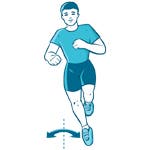Your Weeklong Dream Trip

The Demands
Can you say Sherpa? Hauling a 40-pound load around for just a couple of miles is challenging; doing it for 7 days in a row in mountainous terrain requires rock-solid legs, core, and shoulders. The strategy You want backpack-carrying strength most of all, so our plan gets into your wheelhouse with exercises that target glutes, hamstrings, quads, and core. Your schedule also includes lots of low-intensity cardiovascular activity–remember, this isn’t a sprint.


The Workout
Here’s the executive summary: Do two strength circuits a week, both after a cardio session; schedule 48 hours between strength workouts for muscle recovery. Just as importantly, take Monday and Friday off so you have rest before and after a hard weekend.
Get Fit: The Overview
On weekdays, plan on three distinct cardio sessions: one trail run, one hike with a 20-pound pack, and one climbing session (use stairs or a stair stepper). Begin with 40-minute sessions; each week, add 5 to 10 minutes to your runs and climbs and 15 minutes to your hikes. Keep your effort at a sustainable level; intensity isn’t as important as endurance.
On weekends, spend one day doing your cardiovascular activity of choice: mountain biking, dayhiking, or anything else that gets your heart pumping. Start with 75 minutes, and work up to 4 hours about 3 weeks before your trip. Hike the other weekend day. Progress from carrying 50 percent of your full pack weight and daily distance and elevation gain to carrying a full pack and covering 75 percent of the daily mileage and elevation gain by 3 weeks out. The weight is essential in this training regimen; no matter how strong you are, your body has to acclimate to the specific demands of wearing a pack. On the next several pages you’ll find an 8-week, 7-day training plan to really help you get fit.
Week 1 | Week 2 | Week 3 | Week 4
Week 5 | Week 6 | Week 7 | Week 8
Strength-Training Exercises | Extra Credit
Click here to download the 8-week training plan.
*RPE refers to the rate of perceived exertion, a fancy sounding term that merely expresses the difficulty of a workout from one to ten. An RPE of 1 means you’re barely breaking a sweat; a 10 means you’re burning in lactic hell.
Click here to download the 8-week training plan.
Build Strength
These exercises will give you the strength and endurance you’ll need to go the distance. Do three sets of 8 to 10 reps of each activity, unless otherwise noted. For exercises that require wearing a pack, start with 50 percent of the weight you expect to carry and increase it by 10 percent each week.
1. Squat wearing pack
Builds: Quads, hamstrings, glutes
Stand with your feet hip-distance apart, arms extended or lightly grasping trekking poles for support. Look straight ahead and bend your knees, making sure to sit back so that your knees stay aligned over your ankles. Do not bend past 90 degrees; return to start.

2. Step-up/Heel-down wearing pack
Builds: Quads, hamstrings, glutes, calves, hips, and climbing/descent-
specific strength
A. Use a platform (a step, chair, or stable rock) high enough so your thigh is parallel to the ground when you step up. Step up with your left leg, putting your whole foot on the step, then follow with your right. Lower your right leg to the ground, then left. Do 8 to 10 reps on each side.

B. Stand on top of the platform, facing out, and lower your left leg so the heel touches the ground, then return to starting position. Do 8 to 10 heel touches on each side.

3. Windshield wiper
Builds: Core strength
Lie on your back with your arms extended to the side, and raise your legs so that they’re perpendicular to the floor. Keeping your legs glued together, lower them to the left–go down as far as you can without your upper torso coming off the floor–then bring them back to center. Then lower them to the right and return to center to complete one rep.

4. Woodchopper
Builds: Core strength, shoulders
Stand with your feet hip-distance apart, holding a 10-pound pack overhead. Squat down, touching the pack to the ground directly in front of your toes–your back will have a slight “C” shape. Return to starting position, then squat and touch the pack on the outside of your right foot; back to start. Touch in the middle, then to the outside of your left foot. Do a total of 8 cycles.

Extra Credit
Practice yoga once a week. Carrying a backpack compresses your spine, and yoga postures such as downward dog and the sun salutation stretch it out again. (Both can be done anywhere and are beneficial morning rituals before a day of trekking.) To learn more about these and other yoga poses, check out www.yogajournal.com.
Use your training hikes to fine-tune pack fit and break in your boots, so you don’t spend the first day of your trip futzing with straps and moleskin to eliminate sore spots.
At the gym–or just using gallons of water at home–do sets of shoulder raises, both to the front and sides. Building shoulder and upper-back strength helps ease the burden of lifting your pack and makes it easier to maintain a comfortable posture all day on the trail.